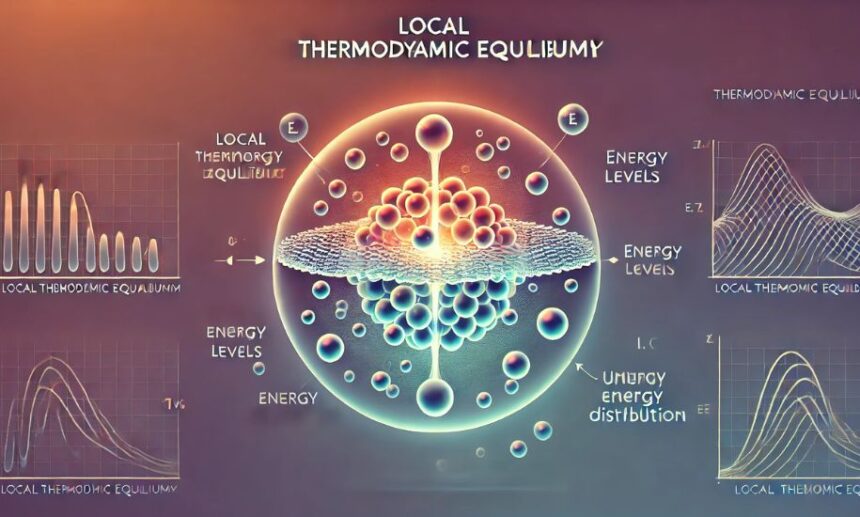In the realm of thermodynamics and statistical physics, local thermodynamic equilibrium is a fundamental concept that helps us understand the behavior of particles and energy distribution within a system. At Physics Heaven, we aim to simplify complex scientific concepts, and in this article, we will explore the meaning, significance, and applications of local thermodynamic equilibrium in various physical systems.
What is Local Thermodynamic Equilibrium?
Local thermodynamic equilibrium (LTE) refers to a state in which a small region of a system appears to be in thermodynamic equilibrium, even though the entire system may not be in equilibrium. In simpler terms, the particles within a small localized region exhibit equilibrium properties such as uniform temperature and energy distribution. However, this does not necessarily mean that the whole system is at equilibrium.
In LTE, the distribution of particle energies follows the Maxwell-Boltzmann distribution for gases and the Planck distribution for radiation in plasmas. This assumption simplifies many calculations in thermodynamics, astrophysics, and fluid dynamics.
Conditions for Local Thermodynamic Equilibrium
For local thermodynamic equilibrium to be valid, certain conditions must be met:
- Sufficiently High Collision Frequency: The interactions between particles should be frequent enough to ensure that they rapidly reach equilibrium within the local region.
- Small Spatial Variations: Temperature, pressure, and density should not vary significantly over short distances within the system.
- Timescale Considerations: The timescale of local interactions should be much shorter than the timescale over which the macroscopic properties of the system change.
When these conditions are satisfied, we can assume that thermodynamic properties such as entropy, energy, and distribution functions apply to small regions within the system.
Applications of Local Thermodynamic Equilibrium
The concept of local thermodynamic equilibrium plays a crucial role in various scientific disciplines. Below are some of the key areas where it is applied:
1. Astrophysics and Stellar Atmospheres
One of the most significant applications of local thermodynamic equilibrium is in astrophysics, particularly in the study of stellar atmospheres. The radiation emitted by stars often follows the Planck distribution under LTE assumptions, allowing scientists to model stellar spectra more accurately. However, in some high-energy astrophysical environments, non-LTE effects become important and must be considered.
2. Plasma Physics
In plasma physics, LTE is an essential assumption for modeling high-temperature plasmas, such as those found in fusion reactors and interstellar environments. In these cases, the interaction between ions and electrons helps maintain local equilibrium, even when global equilibrium is not present.
3. Fluid Dynamics and Atmospheric Sciences
Local thermodynamic equilibrium is often assumed in fluid dynamics and atmospheric sciences to simplify the analysis of heat transfer and gas interactions. For instance, in weather models and climate simulations, LTE assumptions help describe energy exchange in the atmosphere.
4. Spectroscopy and Radiative Transfer
Spectroscopic studies of gases and plasmas often rely on LTE to determine temperature and density profiles. In radiative transfer equations, the LTE assumption allows scientists to use known equilibrium distributions to calculate emission and absorption coefficients more effectively.
Differences Between Local and Global Thermodynamic Equilibrium
It is essential to distinguish between local thermodynamic equilibrium and global thermodynamic equilibrium:
- Global Thermodynamic Equilibrium (GTE): The entire system is in equilibrium, meaning there are no macroscopic flows of energy or matter, and all properties are uniform throughout the system.
- Local Thermodynamic Equilibrium (LTE): Only small regions within the system are in equilibrium, while the overall system may still be changing or evolving over time.
In many physical and astrophysical systems, LTE is a more practical assumption than GTE, as real-world systems often exhibit temperature and density gradients.
Limitations of Local Thermodynamic Equilibrium
While local thermodynamic equilibrium is a useful approximation, it has some limitations:
- Breakdown in Low-Density Environments: In regions where particle collisions are infrequent, such as in the upper atmospheres of stars or in interstellar space, the LTE assumption may not hold.
- Non-Equilibrium Effects in Fast-Changing Systems: When the timescale of external forces or radiative processes is shorter than the collision timescale, the system may deviate from LTE.
- High Energy and Quantum Effects: In some extreme conditions, quantum mechanical effects and relativistic interactions may dominate, requiring more complex models beyond LTE.
Conclusion: The Importance of Local Thermodynamic Equilibrium
Local thermodynamic equilibrium is a foundational concept in thermodynamics, astrophysics, plasma physics, and atmospheric science. At Physics Heaven, we emphasize the importance of understanding LTE, as it provides a bridge between microscopic interactions and macroscopic behavior in complex systems.
While LTE simplifies many scientific models, it is essential to recognize its limitations and the conditions under which it applies. As researchers continue to explore high-energy physics, quantum mechanics, and space environments, refining the understanding of LTE will remain crucial in advancing our knowledge of the universe.








